- Yokohama-shi Top Page
- Health, Medical and Welfare
- Health and Medical Care
- institute for health
- Pharmaceutical Affairs Information
- Do you know how to use kusuri correctly?
Here's the text.
Do you know how to use kusuri correctly?
Last Updated December 26, 2024
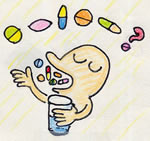
The kusuri passed at hospitals, clinics, and pharmacies is written on the bag containing the kusuri (called yakutai medicine bag). In addition, please read the detailed information on how to drink cosmles in the drug information report form.
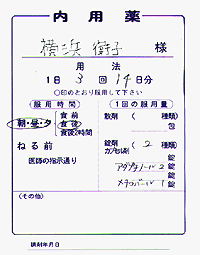
Medicine bag
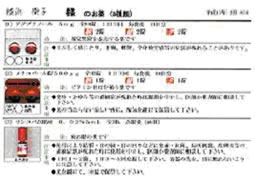
Kusuri's Manual
* At pharmacies, pharmacists explain in detail which cosmles work for what.
In addition, if you buy a commercially available cosm, it always contains an "attached document". Among them, how to drink cosin, that is, "how" and "dosage" are always described. If you have any questions, consult your doctor, pharmacist, or registered seller.

Attached document “Table”
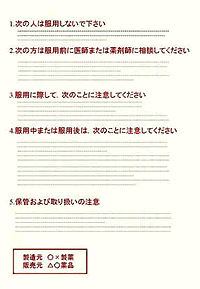
Attached document “Back”
When do you drink kusuri?
| Display | How to drink |
|---|---|
| Before meals | Drink about 30 minutes to 1 hour before eating |
| Between meals | Drink about 2 hours after eating |
| After meal | Drink about 30 minutes after eating |
| Time interval | Drink every time specified (6 hours or 8 hours) |
| Before going to bed | Drink 30 minutes to 1 hour before going to bed |
| Tidy clothes | Drink only when it is hard due to high fever or pain. |
How much do you drink?
The amount of cosn depends on the type of cosn, depending on whether it is a child or an adult. When you drink, read the medicine bag or attached document carefully to see how much you drink.
The worst thing is to drink twice just because you inadvertently forget to drink. Don't just stop this.
Can pregnant women drink cosmetic?
For more information on how to take medicine during pregnancy and breastfeeding, please refer to the National Center for Adult and Medical Research website (outside site).
I don't drink the kusuri out of the sheet
There are many cases where you drink without removing the cosm from the sheet (PTP sheet) that wraps the cosm.
The coslic sheet itself is not toxic when drunk, and is discharged with the stool without digesting in the stomach and intestines. However, there is a risk of damaging the esophagus and other mucous membranes at the sharp corners of the sheet, so be sure to push the cosmos out of the sheet and drink it as shown below.
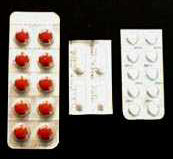
Kusuri wrapped in a PTP sheet
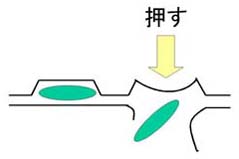
The figure above is also printed on the back of many PTP sheets.
It is taken by grinding the tablet or taking out the contents of the capsule.
In order to gradually dissolve in the stomach, or to dissolve in the intestine without dissolving in the stomach, it can be coated or capsuled according to its stability and purpose. If you grind and drink the tablet or take out the contents of the capsule, the blood concentration will suddenly rise, or what originally dissolves in the intestine will melt in the stomach and do not work, which is dangerous . Talk to your doctor or pharmacist if you want to give a child who cannot drink cosm, such as tablets or capsules.
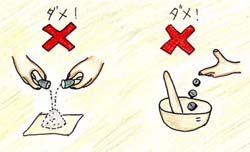
Suppositive
Recent advances in formulation technology have led to an increase in suppositives such as antipyretics and antibiotics. However, be aware that suppositives are never a medicine. First, take it out of the packaging and insert it into the buttocks from the pointed point.
If you receive half instructions, cut it diagonally with a clean cutter knife. Make the cut tip a little soft before inserting it into your hips.
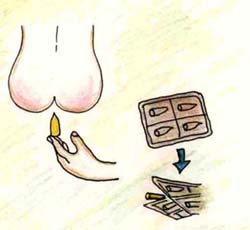

Suppositives may dissolve if stored in a warm room, so some may be stored in the refrigerator. However, depending on the type of suppositive, the temperature of storage differs, so ask your pharmacist for detailed storage methods.
- Reference Books
Easy-to-understand knowledge of drugs (New Japan Law)
As has been said for a long time, there is a "meeting" when eating, and when taking medicine, there is a "meeting". Here, we will introduce the very basic "drinking together".
Medicines for hypertension and grapefruit (including juice)
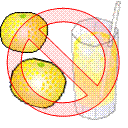
In some hypertension drugs (calcium antagonists), taking them with grapefruit (including juice) makes it harder for the drug to break down and increases the concentration of the drug in the blood. As a result, avoid eating grapefruit, as side effects such as flickering and headaches may come out, or the medicine may be too effective. You can eat oranges and lemons.
Please consult your doctor or pharmacist for more information, as some citruss may or may not be eaten.
Antibiotics and Milk
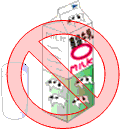
Drinking milk with antibiotics (tetracyclines) or antibiotics (new quinolones) reacts with milk's calcium and iron and is not absorbed, resulting in poor efficacy. When you take medicine, take it with water.
Warfarin and Natto
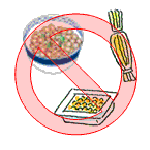
Warfarin suppresses the action of vitamin K (activating blood coagulation factors) to make blood harder to solidify and prevent blood clots from being formed. Natto bacteria contained in natto make vitamin K in the intestine, so eating natto reduce the effect of walfalin. Do not eat natto while taking warfarin. In addition to natto, green juice and spinach also contain a lot of vitamin K, so be careful of intake in large quantities.
Medicine for rhinitis, cheese, wine, tarako, etc.
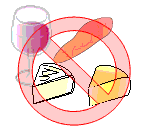
Often contained in rhinitis drugs (phenylpropanolamine) is a drug that acts on the sympathetic nervous system and contracts blood vessels. Chilamin contained in cheese, wine, tarako, etc. also has the effect of stimulating the sympathetic nervous system, so ingesting these foods increases the effect of phenylpropanolamine, increases blood pressure, and risks such as cerebral infarction and facial high tides. In addition, eating cheese, wine, etc. that are high in chilamin while taking antidepressants (MAO inhibitors) can prevent the decomposition of chilamin, increase the effect of chilamin, which is dangerous because blood pressure increases.
Supplements and antiepileptic drugs, centric drugs, immunosuppressive drugs, oral contraceptives, anti-HIV drugs, etc.
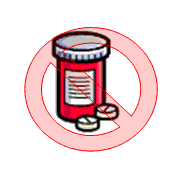
Some supplements that you take in consideration of your health need to be careful when using them with medicines. Pay close attention to supplements that contain St Jones Wart (Western Atogirisou).
In this way, depending on the medicine and food, there is "drinking together". Please follow the guidance of your doctor or pharmacist when taking medicine.
Link
For more information on how to take medicine
For consultation on kusuri, the Japan Pharmacists Association
Consumer Telephone Consultation Service TEL 03-3353-2251
Inquiries to this page
RIKEN, Medical Care Bureau Institute of Hygiene
Telephone: 045-370-9451
Telephone: 045-370-9451
Fax: 045-370-8462
Email address: ir-eiken@city.yokohama.jp
Page ID: 497-420-006







